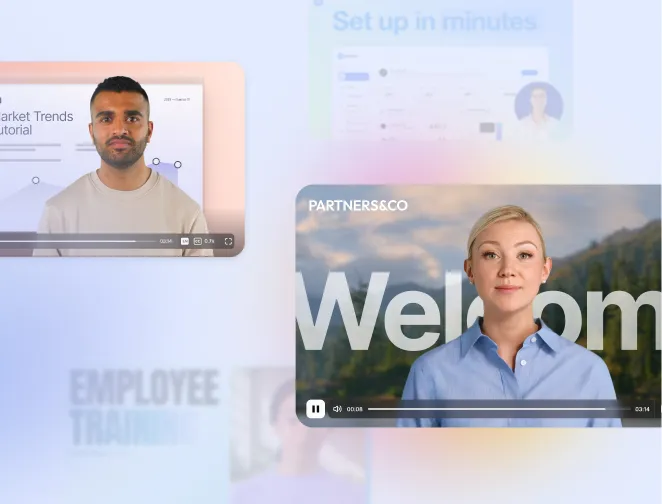
Create AI videos with 230+ avatars in 140+ languages.
Your training videos are underperforming.
I hear this from L&D teams every week. Learners drop off mid-course, completion stalls, and knowledge just doesn’t stick.
If you've ever been involved with building an employee training program, chances are you've come across the term microlearning once or twice.
While microlearning as part of employee training isn't a novel concept, combining microlearning with video-based learning has been steadily rising in popularity.
The data shows they can boost knowledge acquisition by up to 41% compared to traditional formats.
This guide will show you how to build short, focused videos that engage learners, scale easily, and actually make an impact.
Why are microlearning videos the perfect vessel for learning?
1. Microlearning is more cost- and time-effective
This statement doesn't only apply to videos, but to microlearning as a whole.
According to learning expert Ray Jimenez, Ph.D., creating microlearning content instead of traditional learning methods can increase the speed of development by 300% and decrease cost by 50%.
Microlearning modules are easier and faster to create because they don't require in-person subject matter experts, classrooms, or expensive equipment to create.
Besides, digital microlearning modules are easier to maintain and keep up to date than traditional course materials.
2. Microlearning breaks up information into easily digestible components
The roots of this statement stem from Miller's Law, which states that the number of objects a person can hold in their short-term memory is limited to about 7 plus/minus 2.
However, if objects in short-term memory are not being pushed out by competing stimuli, they can get embedded into long-term memory.
How does that translate into microlearning? If information is presented in short chunks targeting one objective without competing stimuli, the likelihood of the information being remembered is higher.
3. Microlearning delivers measurable business outcomes
In my experience working with enterprise customers, the organizations that see the biggest wins are those using microlearning for just-in-time support—quick answers when employees need them, not lengthy courses they have to schedule.
The business impact is real. Companies using microlearning videos report faster onboarding times, with some reducing their training period by up to 50%.
Completion rates soar compared to traditional hour-long sessions, and employees actually retain what they learn.
One of my clients saw their support ticket volume drop by 30% after implementing microlearning videos for common troubleshooting tasks.
4. Microlearning video content is more engaging
According to a study from MIT researchers analyzing 6.9 million video watching sessions, shorter videos are much more engaging.
They follow up with a recommendation to keep the videos less than 6 minutes long for best engagement.
How to make microlearning videos in 5 easy steps
Producing videos, especially multiple videos, is a lengthy and often expensive undertaking, that involves multiple stakeholders.
To create microlearning videos quickly and on a budget, I recommend using an online AI video maker like Synthesia.
Step #1: Choose a microlearning video template
One aspect of video content creation that takes up a large chunk of time is design.
Choosing the right background, finding the right stock footage, and adding transitions and animations - all that can be bypassed by using video templates.
We have made the job easy for you by creating a wide variety of video templates.
Simply add the template to the video canvas whole or just use individual scenes and combine them to your liking.

You can also browse our searchable video library for inspiration. All our training video templates have been professionally-designed, and are fully cloneable and customizable.
Step #2: Prepare a short video script
Now prepare a short video script that goes well with the template outline. I suggest you check out our guide to writing a video script.
Here's the formula I use for maximum impact:
Step #3: Paste your script and choose a voice
Head over to the video canvas and paste your microlearning video script into the script box slide by slide.
You will notice that the tool automatically chooses a language and voice style to create a text-to-speech narration. You can change to a different voice, and you also create microlearning videos in more than 140 languages.
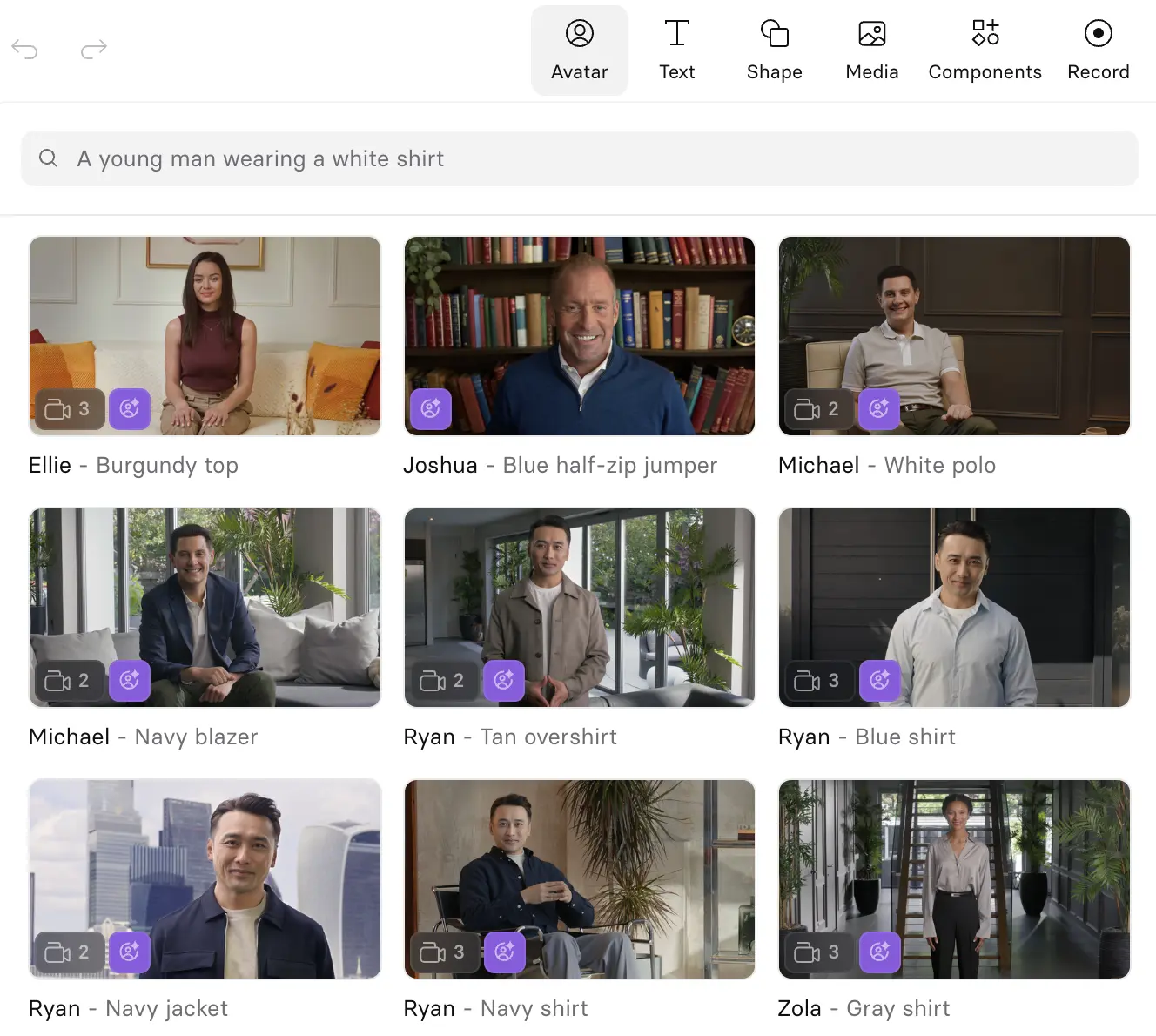
You can also use expressive avatars to add more personality and engagement to your learning companion. I've found them especially effective for onboarding and soft skills training.
Step #4: Personalize video
If you're creating a microlearning video from a template, you don't have to personalize it, but it always helps.
You change up every element in the template: images, videos, shapes, animations, transitions, text, and AI avatars. I also always make sure I'm using the correct brand colors for the project I'm working on.
I'll typically leverage stock media to quickly find relevant images and videos, but you can also generate your own with a variety of AI models.

Step #5: Generate video
Your microlearning video is now complete!
Click on 'Generate' and the video will be processed in a few minutes.
If you have made personalized changes to the video that you would like to duplicate across multiple short microlearning videos, turn it into a template by clicking on 'Create template' on the video sharing page.
6 tips for creating engaging microlearning videos
Now that you're familiar with the step-by-step process of creating microlearning videos, check out these expert tips for making the best microlearning videos for employee training.
1. Keep the video short
A successful microlearning video is anywhere between 30 seconds and 3 minutes in length.
If it's any longer than 3 minutes, it's not micro anymore. 😉
But here's what I've learned from analyzing thousands of videos: the sweet spot depends on your content type. For quick procedural tasks, aim for 60-90 seconds. For concept explanations, 2-3 minutes works well.
Research shows that videos under 5 minutes maintain the highest engagement, with 100% of learners preferring this length. The MIT study referenced earlier found that engagement drops significantly after 6 minutes, so if your script runs longer, it's time to split it into a series.
Microlearning training content is meant to be consumed on the fly and at the learner's own pace, so keep the long training sessions for another day.
2. Focus on 1 learning objective
Based on what we've discussed above regarding Miller's Law, sticking to 1 learning objective for the entire video with no competing stimuli will enable learners to retain that information in their long-term memory.
Besides, it's pretty difficult to cram in more than one topic into such a short video anyway.
3. Microlearning videos should be self-contained bits of teaching
On their own, microlearning videos should be able to provide enough laser-focused information to teach a skill. Learners should be able to understand what they need to from just the piece by itself.
As our in-house learning expert Kevin explains it:
Think of microlearning videos as TikTok videos. You don't need to know the full backstory... you understand a moment as a whole by watching it. You get all the valuable information you need just by watching that one tiny experience.
We couldn't have said it better, Kev.
4. Minimize distractions
Remember Miller's Law?
If we want our learners to retain information, we have to omit any competing distractions or stimuli.
That means, when creating microlearning videos, remember to:
- Focus on one learning objective
- Present information in a clear and concise manner
- Not add too many visual stimuli in your microlearning videos
5. Use a learning companion
At the core of this statement lies the Personalization Principle developed by R. Clark and R. Mayer.
According to the principle, we as humans are social creatures that like sharing knowledge. We learn better when we're having a conversation, and when we're spoken to politely and informally.
Adding a visual character can simulate a person-to-person interaction and, in turn, increase learner engagement.
That can be done by either including a human presenter in the video or using a lifelike AI-generated avatar to do the same job.
6. Add interactive elements to boost retention
Synthesia’s Interactivity lets you turn videos into dynamic experiences with clickable buttons, branching paths, and built‑in quizzes that score responses and surface analytics—all inside Synthesia’s player.
Buttons can open links or jump between scenes to create non‑linear “choose‑your‑own‑adventure” flows, and interactive videos can be published via share links, iframe embeds, or SCORM with LMS tracking.
While Synthesia videos can include interactive elements, you can also design your script to include "pause and practice" moments that encourage active learning.
Even in a 90-second video, you can pause and ask, 'Which option would you choose here?' Then reveal the answer.
I then like to follow up with a 1-2 question quiz. Customers tell me this simple addition dramatically improves knowledge retention.
5 Microlearning video layout ideas
If you're creating microlearning content from scratch or transforming your existing microlearning modules from text into video, knowing how to visualize information can be challenging at first.
Here are a few visual layout ideas for your next microlearning video, showing you how to simplify ideas for learning content in a video format.
1. Key objectives slide
This bold layout with bullet points is perfect for outlining the single learning objective for the microlearning module.
I suggest to use this at the beginning of the video to let your viewers know what to expect.
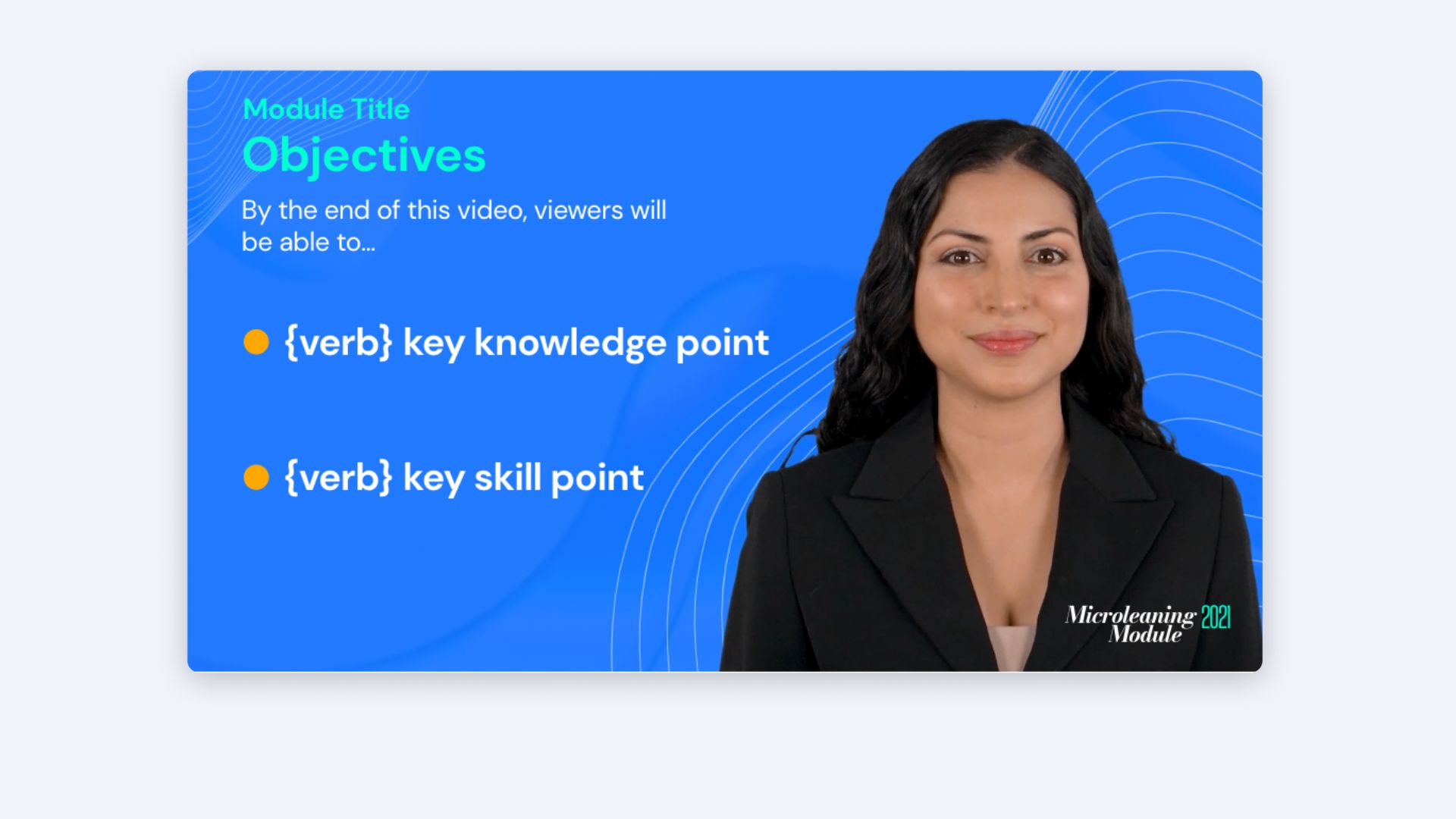
Use Bloom's verbs to write the objective.
Let me show you a concrete example of Bloom's active verbs in action: at the end of this blog post we would like you to be able to
- Describe why microlearning videos are important
- Apply the 5 essential tips to your video creation process
- Create a microlearning video using Synthesia
2. Comparison slide
This slide layout has placeholders for on-screen text to compare two different groups or terms.
A comparison is a useful tool that helps viewers draw parallels between the new concept and something they are already familiar with. I've found this works perfectly for 'old way vs. new way' or 'option A vs. option B' scenarios.
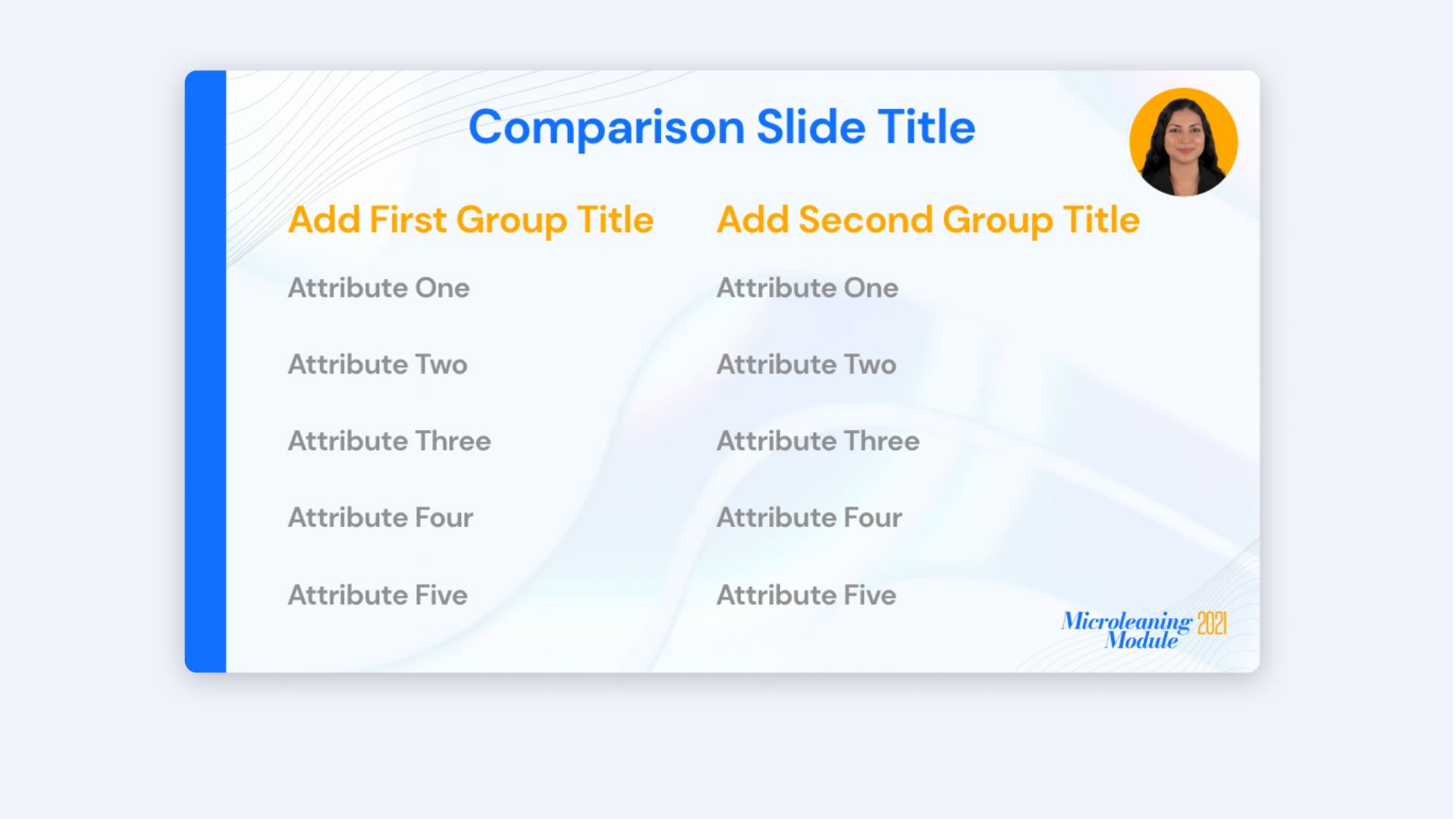
3. Slide for key visuals
Engage learners by breaking up text with visuals. Video is a visual medium, after all.
Frame the content of your slide with the title, and use no more than 3 key points to call out from your visual on the right side. I favor this style of slide when I'm building process demonstrations or showing real product interfaces.
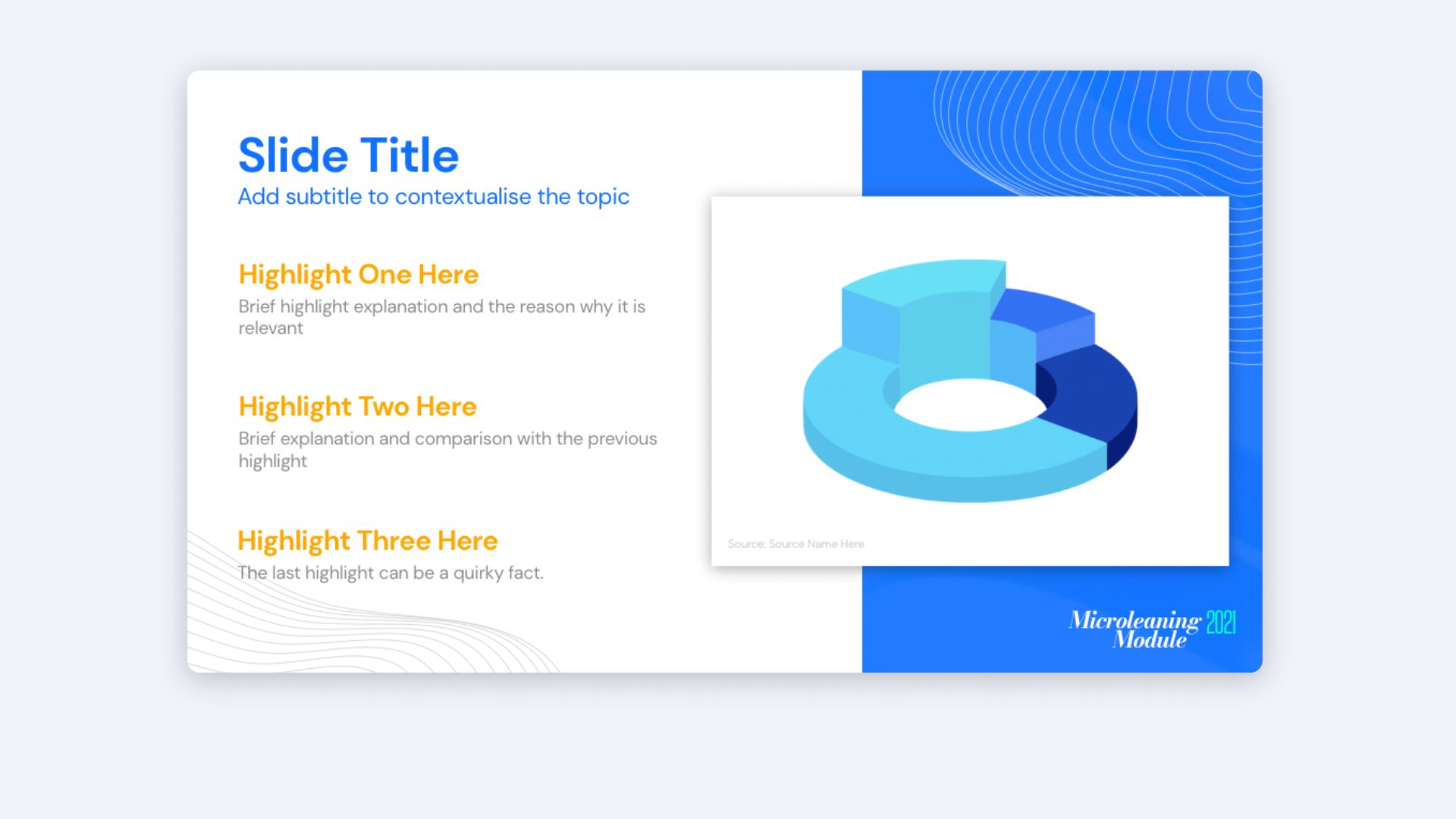
4. Knowledge check slide
Engage viewers and increase knowledge retention by including a quick knowledge check.
In this example we use a short multiple-choice quiz to create interesting learner interactions. I recommend including one of these every 2-3 videos in a series to reinforce learning.
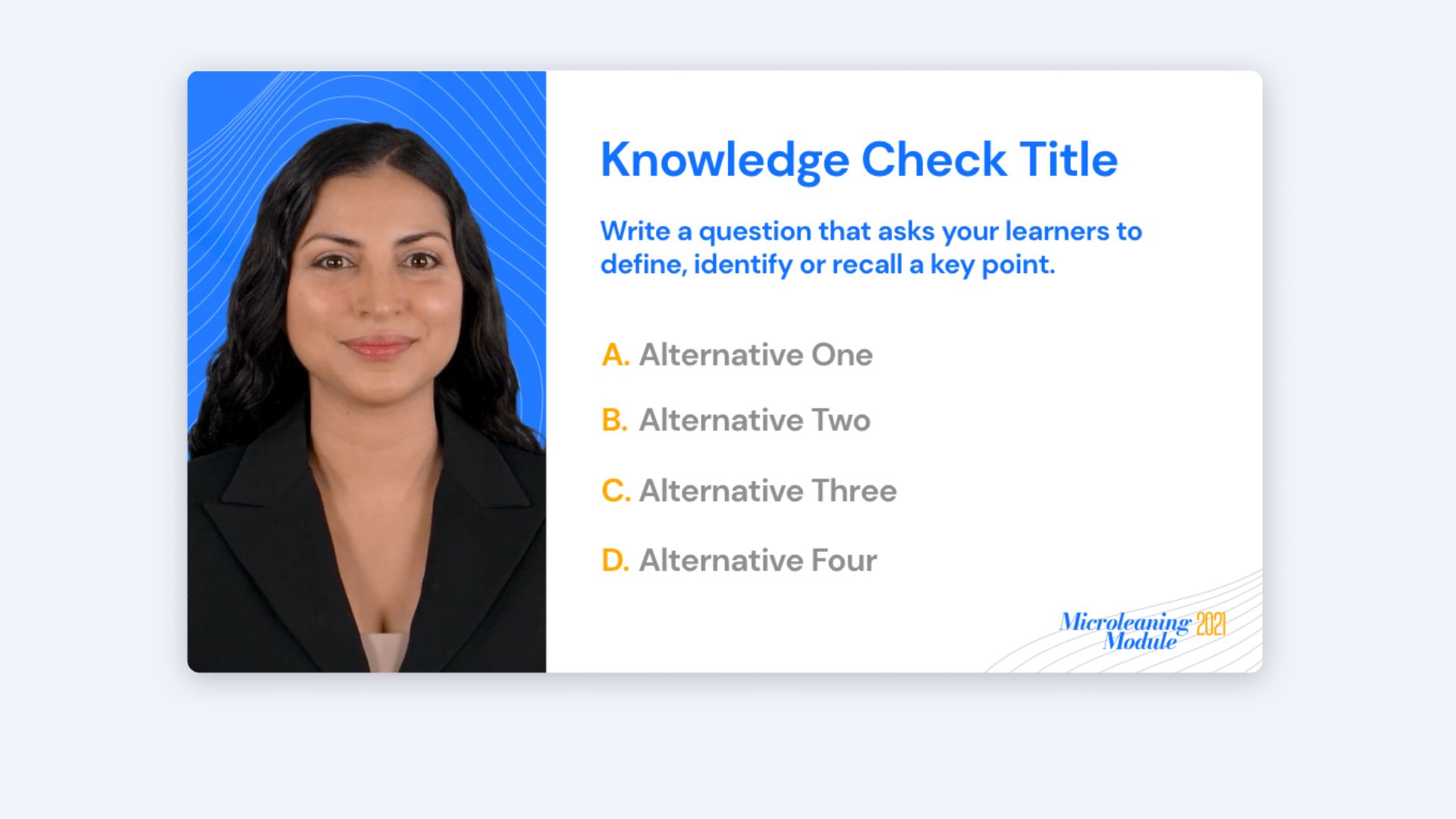
5. Key takeaways slide
Recap the learning module by providing up to 3 key takeaway points lead your learners to any additional resources for more information. I pretty much always end with this to cement the learning objective.
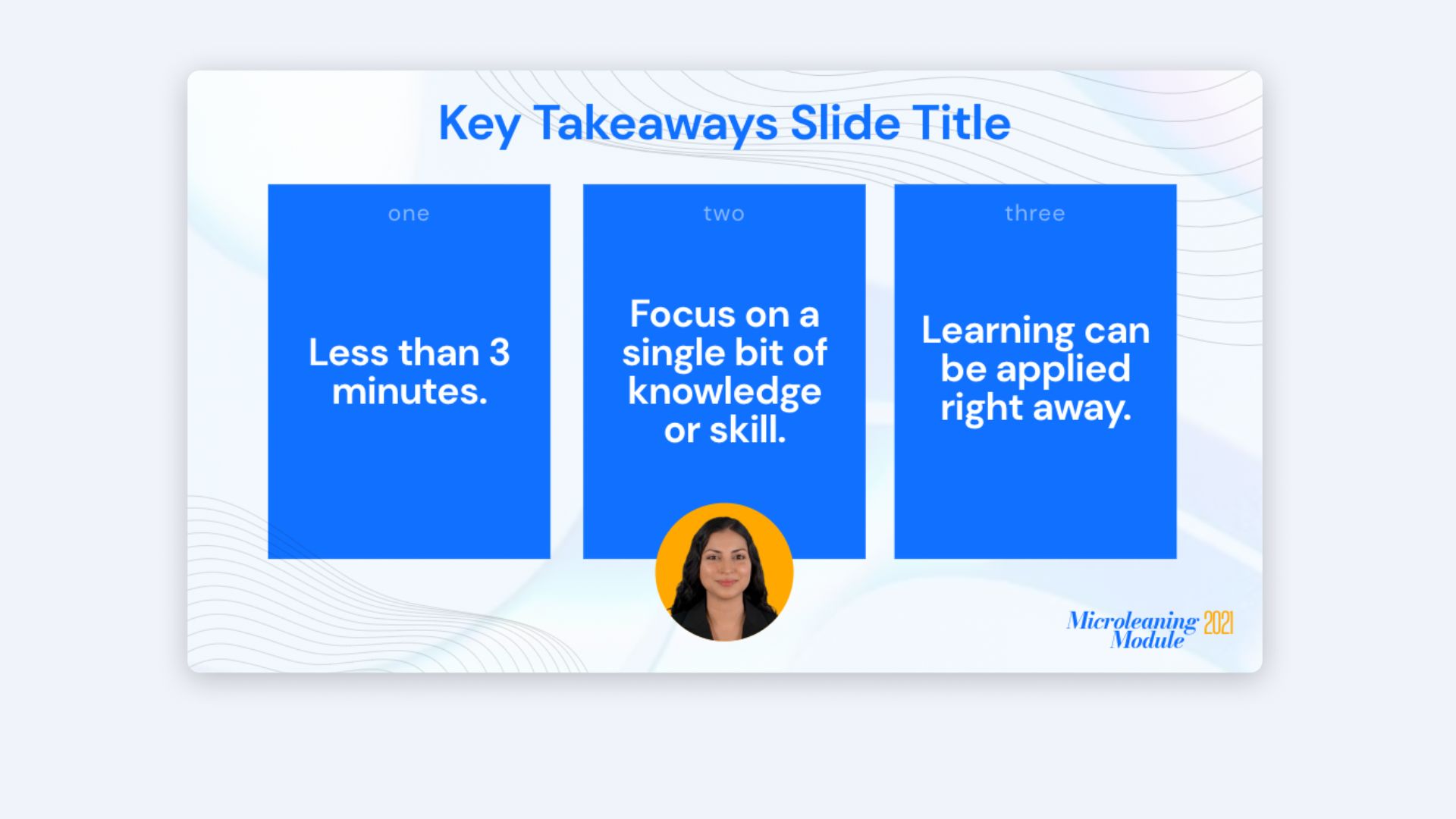
Feel free to use these as an inspiration for your microlearning videos.
How to measure microlearning video effectiveness
I always tell customers: what gets measured gets improved. The organizations I work with that see the best results are tracking both engagement metrics (completion rates, watch time) and business outcomes (time to productivity, support ticket reduction).
Start simple—even just tracking completion rates will tell you if your videos are hitting the mark.
Track completion rates and engagement using either Synthesia's video analytics or through your LMS using SCORM.

This gives you detailed analytics on who's watching, how much they're completing, and where they might be dropping off.
You can also monitor knowledge retention through pre/post assessments to see if the information is actually sticking.
Don't forget to gather qualitative feedback from learners. I've found that sometimes the most valuable insights come from a simple "Was this helpful?" survey. I like to look for business impact metrics too: faster onboarding times, reduced support tickets, improved performance scores. These are the numbers that really matter to leadership.
About the author
Strategic Advisor
Kevin Alster
Kevin Alster is a Strategic Advisor at Synthesia, where he helps global enterprises apply generative AI to improve learning, communication, and organizational performance. His work focuses on translating emerging technology into practical business solutions that scale.He brings over a decade of experience in education, learning design, and media innovation, having developed enterprise programs for organizations such as General Assembly, The School of The New York Times, and Sotheby’s Institute of Art. Kevin combines creative thinking with structured problem-solving to help companies build the capabilities they need to adapt and grow.

Frequently asked questions
How do I create a microlearning video in 5 minutes with Synthesia?
Creating a microlearning video in Synthesia takes just five simple steps that you can complete in minutes. Start by choosing a microlearning video template from the template library, then prepare a short script of 100-150 words focusing on one learning objective. Next, paste your script into the video canvas and select an AI avatar and voice from over 140 languages available. Personalize the video by adjusting colors, images, and animations to match your brand, then click "Generate" to create your video.
The entire process eliminates traditional video production barriers like cameras, studios, and actors. You can create multiple variations quickly by saving your personalized video as a template for future use. This streamlined approach means you can produce professional microlearning content at scale, updating training materials instantly when information changes rather than scheduling costly reshoots.
How long should a microlearning video be to maximize engagement?
Microlearning videos should be between 30 seconds and 3 minutes long to maintain optimal engagement and knowledge retention. Research from MIT analyzing 6.9 million video sessions shows that engagement drops significantly after 6 minutes, with the highest engagement rates occurring in videos under 5 minutes. The sweet spot depends on your content type: procedural tasks work best at 60-90 seconds, while concept explanations can extend to 2-3 minutes.
This short format aligns with modern attention spans and allows learners to consume content on the go. By keeping videos brief and focused on a single learning objective, you increase the likelihood that information will transfer from short-term to long-term memory. Organizations using microlearning videos report completion rates up to 90% higher than traditional hour-long training sessions, making the time investment worthwhile for creating multiple short videos rather than one lengthy presentation.
How should I script and structure a microlearning video for better retention?
Structure your microlearning script using a proven formula: start with an 8-second hook that clearly states what learners will achieve, followed by 45-90 seconds of step-by-step content, a 15-30 second pro tip, and a 10-15 second recap. Aim for 100-150 words per minute of video, which translates to 200-300 words total for a 2-minute video. Use no more than 3-4 sentences per slide to maintain clarity and prevent cognitive overload.
Write in a conversational tone using active voice and simple language that your audience can easily understand. Break complex processes into distinct, numbered steps and display each step title on screen for visual reinforcement. This structure follows cognitive learning principles by presenting information in digestible chunks without competing stimuli, increasing the likelihood that learners will retain and apply the knowledge in their work.
How can I add interactive elements like quizzes or branching to my microlearning videos in Synthesia?
Synthesia's interactivity features allow you to transform standard videos into dynamic learning experiences with clickable buttons, branching paths, and built-in quizzes directly within the platform. You can add buttons that link to external resources or jump between scenes to create "choose your own adventure" style training, while quizzes can automatically score responses and provide detailed analytics on learner performance. These interactive elements work seamlessly within Synthesia's player and can be published via share links, iframe embeds, or SCORM packages.
Even without advanced interactivity features, you can design your microlearning videos to encourage active learning by incorporating "pause and practice" moments in your script. Include knowledge check slides with multiple-choice questions every 2-3 videos in a series, asking viewers to mentally select their answer before revealing the correct response. This approach has been shown to dramatically improve knowledge retention and helps learners actively engage with the material rather than passively watching.
Can I export Synthesia microlearning videos to my LMS (SCORM) and track completion?
Yes, Synthesia supports SCORM export, allowing you to seamlessly integrate your microlearning videos into any Learning Management System for comprehensive tracking and reporting. When you export as SCORM, your LMS can track detailed metrics including completion rates, watch time, quiz scores, and learner progress through interactive elements. This integration ensures your microlearning content works within your existing training infrastructure without requiring additional tools or platforms.
Beyond basic completion tracking, Synthesia's video analytics provide insights into engagement patterns, showing where learners drop off or rewatch sections. You can monitor both individual and aggregate performance data to identify knowledge gaps and optimize your content. Many organizations use this data to demonstrate ROI, with some reporting 30% reductions in support tickets and 50% faster onboarding times after implementing tracked microlearning video programs.














